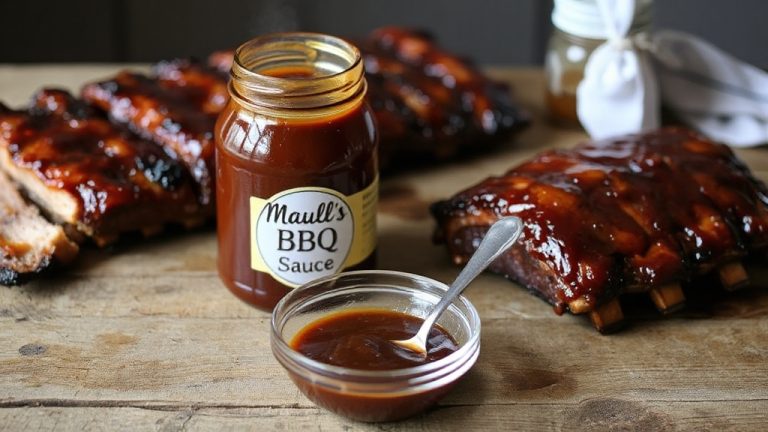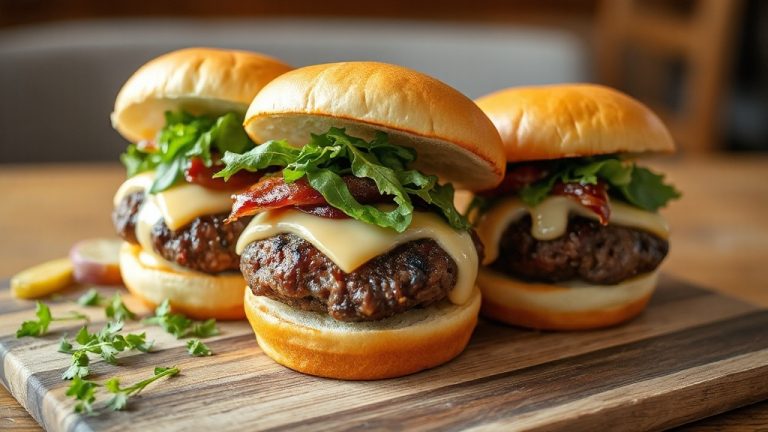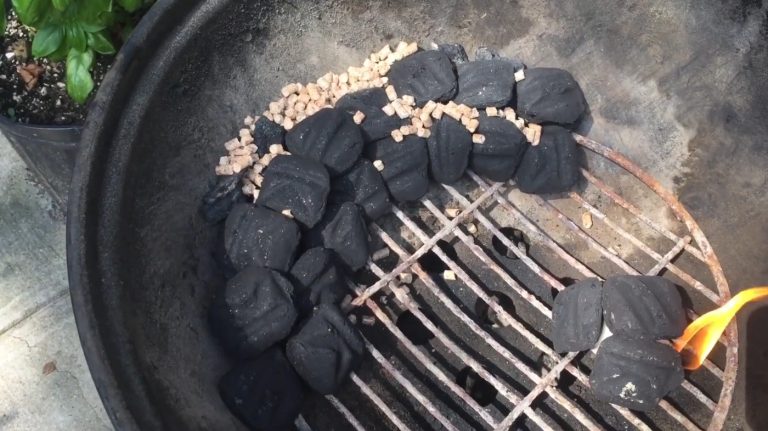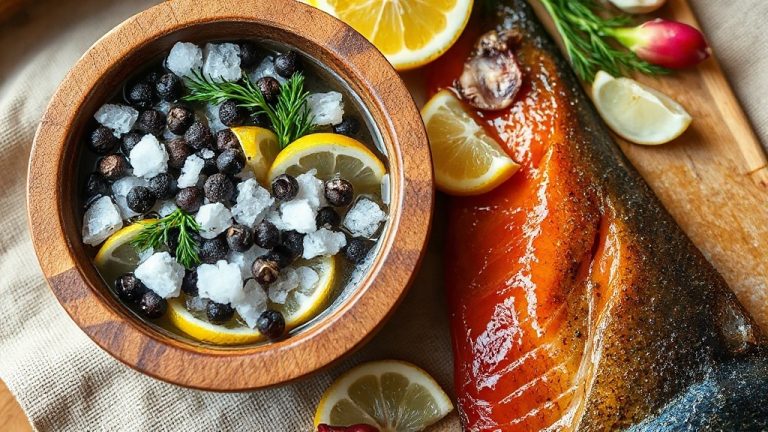Smoked Salmon Little Chief Recipe: Easy Step-By-Step Guide
Choose fresh, firm salmon fillets with skin on, then coat them evenly in a dry brine of brown sugar and kosher salt to enhance flavor and moisture. Let the fish rest refrigerated for 8-12 hours, rinse, and pat dry to form a sticky pellicle.
Set your Little Chief smoker to around 225°F, use soaked apple or cherry wood chips, and smoke the salmon until it reaches 120-125°F internally, finishing with a light glaze for caramelized sweetness. Discover how to perfect each step for stunning, tender results.
Key Takeaways
- Select fresh, high-quality salmon fillets with skin on for optimal flavor and moisture retention before brining.
- Prepare a dry brine of four parts brown sugar to one part kosher salt; apply evenly and brine refrigerated for 8-12 hours.
- Dry the salmon to form a tacky pellicle before smoking for better smoke adhesion and flavor development.
- Use a Little Chief smoker preheated to 225°F-275°F, with soaked fruitwood chips like apple or cherry for mild, balanced smoke flavor.
- Smoke salmon until internal temperature reaches 120-125°F, applying glaze in the last hour and garnish with citrus and seeds for presentation.
Complete Recipe Table for Little Chief Smoked Salmon
| Ingredients | Process |
|---|---|
| 6 lbs fresh salmon fillets (skin-on) | Select firm, vibrant-colored fillets; rinse and pat dry |
| 2 cups brown sugar | Mix with kosher salt in 4:1 ratio for dry brine |
| 1/2 cup kosher salt | Combine thoroughly with brown sugar |
| Wood chips (apple, cherry, or alder) | Soak for 30+ minutes; drain before use |
| Optional: garlic powder, paprika, thyme | Add to dry brine mixture if desired |
| Glaze ingredients (honey, sriracha, brown sugar) | Apply during final hour of smoking |
Ingredients Needed for Smoked Salmon
To craft delicious smoked salmon, you’ll need a few essential ingredients that balance flavor, texture, and aroma perfectly. Start with quality salmon—sockeye offers rich flavor and firm texture, while Atlantic, king, or coho salmon bring delightful variety.
Choose fillets or whole sides, leaving the skin on for extra moisture and taste if you like. For a premium option, consider using whole sides of Honey Smoked Salmon® that are lightly smoked over honey-coated hickory for enhanced flavor.
Proper handling and temperature control during preparation ensure the salmon retains its moisture and safety. For curing, kosher salt is your go-to, paired with brown sugar to balance saltiness with subtle sweetness.
Enhance flavor with herbs and spices like garlic, paprika, and thyme, and consider a light olive oil rub to help seasonings cling. Don’t forget the woodchips—hickory, birch, or maple—soaked to assure steady smoke and impart unique smoky nuances.
Preparing the Salmon for Brining
Start by choosing fresh, high-quality salmon with firm flesh and vibrant color to guarantee the best flavor and texture. Proper handling and storage are essential to maintain the fish’s quality before preparation, especially when using fuels like propane in the smoking process.
Carefully thaw frozen fillets in the refrigerator and trim any uneven edges before gently scoring the flesh to help the brine penetrate evenly.
Handle the salmon with clean hands, keeping the skin intact to hold it together during the brining process. The brining process involves submerging the salmon in a salted solution to ensure flavor absorption and juiciness retention.
Selecting Fresh Salmon
When selecting fresh salmon for your smoked little chief recipe, choosing the right species sets the foundation for flavor and texture.
Opt for King salmon if you want rich, buttery flesh, or Sockeye for deep red color and firm, robust taste. Atlantic salmon offers a milder, versatile flavor, while Coho strikes a balanced note. Ensuring the fish has been properly refrigerated for freshness is key to maintaining quality before brining.
Look for vibrant, deep red-orange to pink flesh with shiny, taut skin showing a bluish tint. The flesh should be firm and spring back when pressed, with no discoloration, slime, or excessive moisture. Avoid dull or mushy pieces.
Buy from reputable fishmongers who handle wild-caught or properly frozen salmon with clear labeling. This care guarantees your smoked salmon starts fresh, ready for perfect brining and smoking.
Choosing wild-caught salmon, especially varieties like Sockeye or King, can provide superior flavor, texture, and nutritional benefits due to their wild-caught origin.
Cutting and Scoring
Although selecting fresh salmon is essential, how you cut and score it directly influences how well the brine penetrates and flavors the fish. Use a sharp, flexible filleting knife to make clean, precise cuts.
A really sharp knife ensures the salmon is sliced cleanly without tearing the flesh. Position the fish flat on a stable board, slicing at a 45-degree angle, moving from tail to head.
Score gently with shallow, evenly spaced cuts across the surface, especially over fattier parts, to boost brine absorption without breaking the flesh. Ensuring consistent cuts helps maintain moisture, which is crucial when smoking in cold weather conditions.
| Cutting Aspect | Key Tip |
|---|---|
| Knife Selection | Long, sharp, flexible blade |
| Scoring Depth | Shallow, uniform cuts |
| Slice Thickness | Thin, translucent slices |
Thawing and Handling
Since proper thawing preserves both texture and flavor, you’ll want to thaw your salmon carefully before brining.
The best way is to leave it in the refrigerator for 12 to 24 hours, keeping it sealed to prevent moisture loss and contamination. Using a refrigerator helps maintain a consistent safe temperature that inhibits bacterial growth during thawing.
If you’re short on time, submerge the sealed salmon in cold water, changing it every 30 minutes until thawed. Avoid thawing at room temperature to keep bacteria at bay.
Once thawed, rinse the salmon briefly under cold water, then pat it dry thoroughly. Use clean hands and sanitized tools to handle the fish, remove any pin bones, and trim any discolored flesh.
Keep the salmon chilled below 40°F during prep to maintain freshness and prepare it perfectly for brining and smoking. Proper brining ensures optimal moisture retention, which is essential to prevent dryness and enhance the flavor of the smoked salmon.
Creating the Dry Brine Mixture
To craft the perfect dry brine, you’ll want to blend four parts brown sugar with one part non-iodized kosher salt. Ensuring this ratio creates a balance that draws out moisture while adding subtle sweetness.
Choosing the right salt is key to avoid off-flavors, so stick with pure kosher salt for a clean cure. Mix the sugar and salt thoroughly to create an even coating that will penetrate your salmon evenly and enhance its natural flavors.
For best results, spread a thin layer of the mixture in the bottom of a 9-inch baking pan before layering the salmon fillets on top to ensure an even cure preparing the brine.
Salt and Sugar Ratio
When you create the dry brine mixture for smoked salmon, balancing salt and sugar is key to achieving the perfect flavor and texture.
A common ratio is one part salt to four parts brown sugar by volume, which gently firms the fish while adding a subtle sweetness. This balance is similar to how Maull’s BBQ Sauce achieves a harmonious blend of sweetness and tang.
For example, use 1/2 cup kosher salt with 2 cups brown sugar for about six pounds of salmon. This ratio draws out moisture, preserves the fish, and helps form a tacky pellicle for smoke adherence. The sugar not only counterbalances saltiness but also encourages beautiful browning during smoking.
Too much salt can overpower, so starting with less is wise—you can always adjust next time. The sugar not only counterbalances saltiness but also encourages beautiful browning during smoking.
Rotate the fish during brining to ensure even penetration and consistent flavor throughout. After two hours of brining, covering the fish with plastic wrap and removing air bubbles is important to prevent spoilage.
Choosing Salt Type
Although selecting the right salt might seem straightforward, choosing the ideal type for your dry brine can make all the difference in flavor and texture. You’ll want to reach for kosher salt, thanks to its large crystals that dissolve slowly, providing a gentle, even cure.
Its coarse grains help draw out moisture uniformly, enhancing the salmon’s texture while avoiding the harshness that finer salts can cause. Avoid iodized or table salts—they often have additives that introduce off-flavors and clumping, leading to uneven curing.
If you’re feeling adventurous, Mediterranean sea salt offers subtle mineral notes that can deepen the flavor profile. Just be sure to store your salt in a dry place to keep crystals intact, ensuring consistent seasoning throughout your smoked salmon creation. Pairing the right salt with slow smoking woods like oak can elevate the overall flavor complexity.
Using the right salt in your dry brine is essential because it controls moisture and enhances flavor by drawing out liquid and allowing the sugar and salt to penetrate the salmon evenly, which is key to a successful cure.
Mixing Dry Brine
Since the key to a perfect smoked salmon lies in the dry brine, you’ll want to mix your sugar and kosher salt thoroughly to guarantee every bite cures evenly.
Use a ratio of four parts brown sugar to one part coarse kosher salt for a balanced sweetness and saltiness that enhances flavor without overpowering.
Combine these ingredients in a non-reactive bowl or Ziploc bag, ensuring a homogeneous blend. Using airtight containers for storage after curing helps maintain freshness and prevent contamination.
You can add optional spices like garlic or onion powder—just avoid extra salt. This dry brine layer, about a quarter-inch thick, draws moisture, firms the fish’s texture, and helps form a pellicle for better smoke adhesion.
Proper mixing and application in a non-reactive container help prevent metal reactions that could affect flavor. Thorough mixing ensures consistent curing, allowing your smoked salmon to develop its signature tender, flavorful character.
Brining Process and Timing
Mastering the brining process is key to opening the rich, moist texture and balanced flavor that makes smoked salmon truly irresistible.
You’ll want to submerge your salmon fully in a cold brine, typically composed of salt, sugar, and water, often enhanced with soy sauce for depth. It is important to avoid using pine wood during smoking, as its high resin content can impart harsh flavors and produce toxic smoke that affects health.
Perfecting the cold brine unlocks smoked salmon’s moist texture and rich, balanced flavor.
Brine thinner cuts for about 3 to 6 hours, while standard fillets benefit from 8 to 12 hours. Thicker fillets may need up to 36 hours but avoid going beyond 48 hours to prevent mushiness and excessive saltiness.
It is important to use kosher salt such as Diamond Crystal, avoiding iodized or anti-caking table salt to ensure the best curing results. Keep the brine refrigerated to maintain freshness and slow enzymatic activity.
After brining, rinse and pat the salmon dry to form a tacky pellicle, essential for smoke adherence and flavor absorption during smoking. Using seasoned hardwoods instead of softwoods like pine will help achieve a cleaner smoke and better flavor profile.
Setting Up the Little Chief Smoker
After you’ve brined your salmon to perfection and formed that tacky pellicle, it’s time to prepare your Little Chief smoker for the smoking process.
Begin by assembling the smoker box, sliding in the chrome-plated grills, and positioning the wood chip pan for easy access without losing heat. The Little Chief smoker includes a Recipes and Operating Instructions Book that offers valuable tips and safety warnings to enhance your smoking experience.
Next, confirm the smoker is plugged into a safe, outdoor electrical outlet—remember, it maintains a steady 165°F temperature ideal for delicate fish.
Place your smoker on a stable, level surface away from wind, rain, and flammable materials. Using seasoned hardwoods such as apple or cherry wood chips can impart a mild, fruity smoke flavor that complements salmon beautifully.
Finally, preheat the unit, fill the wood chip pan with loosely packed chips, and verify all parts are clean and functioning.
- Assemble smoker components inside the housing.
- Connect to an outdoor electrical outlet safely.
- Position smoker on a stable, sheltered surface.
- Preheat and prepare wood chips before loading salmon.
Smoking Techniques and Wood Chip Selection
When you choose the right wood chips for smoking salmon, you set the stage for a delicately flavorful and aromatic experience. Mild woods like alder, cherry, and maple highlight salmon’s natural taste without overpowering it. Fruitwoods such as apple and cherry add a subtle sweetness, while pecan offers a slightly richer note.
Soak your chips for at least 30 minutes to prevent flare-ups and guarantee steady smoke. Drain excess moisture before placing them in the smoker box or directly on heat. Using 3-inch wood chunks or foil-wrapped chips with vents helps maintain controlled burning and even smoke distribution.
Maintain your smoker between 225°F and 275°F, using indirect heat to cook evenly without drying the fish. Monitor temperature regularly, aiming for an internal salmon temperature near 120°F to 125°F. Wrapping chips in foil with vents controls smoke release, balancing flavor beautifully.
Finishing Touches and Flavor Enhancements
Choosing the right wood chips sets the flavor foundation, but adding finishing touches brings your smoked salmon to a new level of complexity and appeal.
Applying a glaze about an hour before the end of smoking adds sweet, savory caramelization—try honey-sriracha or brown sugar blends. Make sure to monitor the internal temperature closely and remove the salmon once it reaches 140°F to ensure perfect doneness.
Selecting the perfect wood chips lays the base; finishing glazes elevate smoked salmon with rich, caramelized flavors.
Dry rubs applied before smoking create a flavorful crust with spices like paprika and garlic powder. Don’t forget to form a pellicle by drying the salmon uncovered; it ensures even smoke penetration and texture.
Finally, brighten your presentation with lemon wedges or toasted sesame seeds for contrast and zest. Resting the salmon for 10-15 minutes after smoking allows flavors to develop fully and juices to redistribute for optimal moisture retention.
- Apply glaze late for caramelized flavor
- Use dry rubs pre-smoking for depth
- Dry uncovered to form pellicle
- Garnish with citrus and seeds for brightness
Frequently Asked Questions
Can I Smoke Other Fish Besides Salmon in the Little Chief Smoker?
Yes, you can smoke other fish besides salmon in the Little Chief smoker. It’s perfect for trout and similarly delicate fish, thanks to its steady 165°F temperature that gently infuses smoke flavor without overcooking.
Just prepare your fish properly, and you’ll enjoy tender, flavorful results. The smoker’s consistent heat and easy operation make it versatile for various fish types, so go ahead and experiment with your favorites!
How Do I Clean and Maintain My Little Chief Smoker After Use?
After smoking, remove the grills, drip pan, and wood chip pan promptly to stop residue buildup. Wash them with warm, soapy water, rinse well, and dry completely to prevent rust.
Wipe the smoker’s interior with a damp cloth and use mild detergent for tough spots. Cover drip pans with foil next time to make cleanup easier. Empty ash and grease trays after every use, and always let everything dry fully before reassembling for lasting performance.
What Is the Shelf Life of Homemade Smoked Salmon Stored Properly?
Imagine biting into that tender, smoky salmon, its rich flavor lingering on your tongue. To keep that delight fresh, you’ll want to store your homemade smoked salmon in the fridge at or below 4°C.
Properly refrigerated, it lasts up to one week, sometimes two if hot-smoked. Freeze it, and you can enjoy it for up to two months. Always watch for off smells or sliminess—they tell you when it’s time to toss it out.
Can I Freeze Smoked Salmon Without Losing Flavor or Texture?
You can freeze smoked salmon without losing much flavor if you wrap it tightly in plastic wrap and aluminum foil or use vacuum-sealed bags. This seals in its rich, smoky taste.
Keep in mind, though, texture might soften slightly, especially if it’s wet-cured. To preserve its best quality, freeze it quickly, avoid thawing and refreezing, and thaw slowly in the fridge. Proper freezing keeps your salmon delicious and fresh!
Is It Safe to Eat Smoked Salmon Without Cooking It Further?
Wondering if you can safely enjoy smoked salmon straight away? Cold-smoked salmon isn’t fully cooked, so it carries some risk of foodborne illness, especially if you’re pregnant, young, elderly, or immunocompromised.
Hot-smoked salmon, however, is fully cooked and safer to eat as is. If you choose cold-smoked, make sure it’s from a trusted source, properly refrigerated, and consumed promptly to savor that silky texture without worry.
Smoked Salmon That Speaks to the Soul
As you pull the golden, smoky salmon from your Little Chief, you’re holding more than just a meal—you’re embracing a ritual of patience and flavor.
Each bite mirrors the gentle dance of smoke and time, like a whispered story told through wood and fish. This recipe isn’t just about cooking; it’s about savoring the art of transformation, where simple ingredients become a feast that warms both palate and soul.






